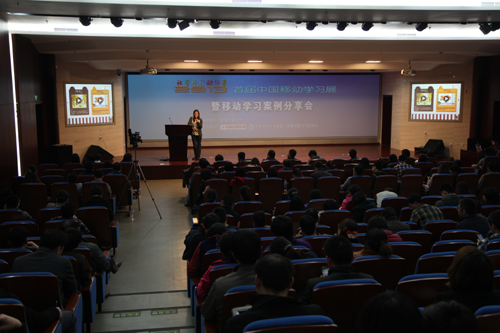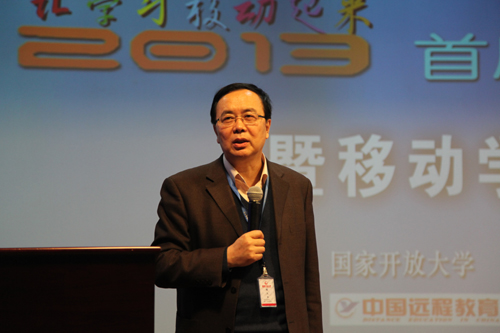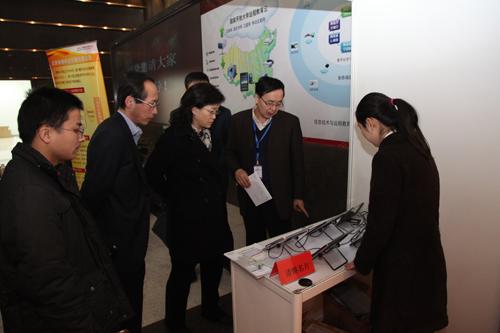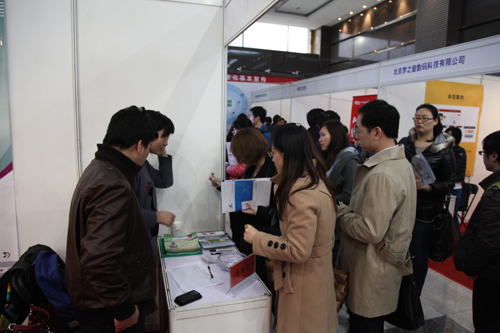
The first 2013 China M-Learning Exhibition and Case Study Conference was held on March 12 in the multi-function hall of the Open University of China (OUC).

Li Qing, associate professor from the Institute of Network Technology at Beijing University of Posts and Telecommunications, attended the conference and conducted a random survey asking audience members, “How many portable electronic devices are you carrying right now?” The survey revealed that the 200+ attendees in the audience each carried at least one device, with some persons carrying up to four devices.
With the proliferation of portable electronic devices today, how do we promote mobile learning (M-Learning)? How to enable learning anytime, anywhere? What is the future of M-Learning? Focusing on the questions above, the OUC hosted “M-Learning — First 2013 China M-Learning Exhibition and Case Study Conference” on March 11-13. The case study conference on March 12 attracted over 200 participants from the industry and OUC faculty and staff.
Smartphones, tablet PCs, smart TVs, personal computers — how do we design mobile learning for these diverse electronic devices? This is the focus of Li Qing’s research. After analyzing the specific characteristics of various devices, he explained that the mobile industry has already entered the era of ubiquitous computing. Mobile phones, tablet PCs, personal computers and smart TVs deliver a smooth multi-screen experience, and future design of mobile learning should first target the mobile phone while keeping in mind various other mobile devices. Li projects that the industry will continue to trend toward multi-screen and ubiquitous characteristics.
Lv Senlin, founder of an M-Learning website, delivered a presentation at the conference in which he predicted the appearance of larger screen phones, smaller tablet PCs, diversified human-computer interaction, wearable electronic devices, full color e-books, flexible screens and so on. He also described the mobile learning industry as trending towards widespread application of tablet PCs in basic education, higher education characterized by M-Learning, publishers embracing M-Learning and digital publication, enterprises experimenting with M-Learning, and the popularization of micro-classes, platform development and course migration technologies.
Companies including Koolearn, Lantop Information Technologies, China National Software & Service, Whaty and GiKoo (Beijing) shared their experiences in implementing mobile learning as well as achievements and hot topics in mobile learning research.

Zhang Shaogang, deputy secretary of the OUC Party Committee, made a speech about learning anytime and anywhere more efficiently with the help of M-Learning. He asked conference attendees to help innovate M-Learning at the national level and guide further development of the field.

Lou Jing (third from left), deputy director-general of the MOE Department of Science and Technology; Dong Weiguo (second from left), head of the MOE Department of Science and Technology High-Tech Division; and Zhang Shaogang at the exhibition

At the exhibition
At the M-Learning exhibition, seven domestic companies involved in M-Learning research and product development (including Lantop Information Technologies, Whaty, CC Video, CidTech, Koolearn and China Mobile Learning Alliance) exhibited advanced M-Learning terminal devices and platforms, and showcased their latest research achievements in M-Learning. The total number of visitors over the three days of exhibition exceeded 1,000.
The exhibition was directed by the OUC and co-hosted by the publisher of China Distance Education magazine, the OUC Department of News and Public and China Mobile Learning Alliance.
By Jin Hongyu and Yu Zhangli, the OUC